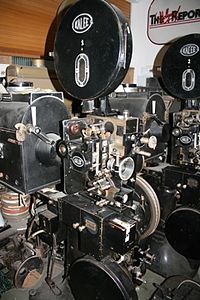Léon Gaumont
This article includes a improve this article by introducing more precise citations. (December 2009) ) |
Léon Gaumont | |
|---|---|
film maker | |
| Years active | 1893–1945 |
| Spouse | Camille Louise Maillard |
Léon Ernest Gaumont (French:
Biography
Léon Ernest Gaumont, born in
Leon Gaumont was married to Camille Louise Maillard (1860-1933)on 4 June 1888. They had five children: Charles, Jeanne, Raymond, Helene, and Louis.
Léon Gaumont's company sold camera equipment and film, but in 1897 inaugurated a motion picture production business. Initially, Gaumont made films for the picture arcade business such as those operated by the

As one of the two dominant forces in film in all of Europe (the other being Charles Pathé), World War I profoundly affected Leon Gaumont's business fortunes. He hired over 300 additional employees, in spite of the fact that Nitrate Emulsion film stocks dwindled because of the need for nitro-cellulose in the munitions industry. Nevertheless, before retiring in 1930, he had built one of the most important film companies in cinema history.
Upon his retirement to Provence, a restructuring of corporate ownership took place through financing provided by the Banque Nationale de Crédit and with a capital stock issue in the name of a new company called Gaumont-Franco-Film-Aubert (GFFA). Four years later, a scandal erupted following the collapse of the Banque Nationale de Crédit and GFFA was forced to file for bankruptcy protection.
Death and legacy
Léon Gaumont died on 9 August 1946 in Sainte-Maxime-sur-Mèr, in the Provence-Alpes-Côte d'Azur region of France, and was buried in the Cimetière de Belleville in Paris. In 1995, on the 100th anniversary of French film, a commemorative silver 100 Franc coin was issued with Léon Gaumont's image.
References
- François Garçon, Gaumont: Un siècle de cinéma, Gallimard, 1994.
